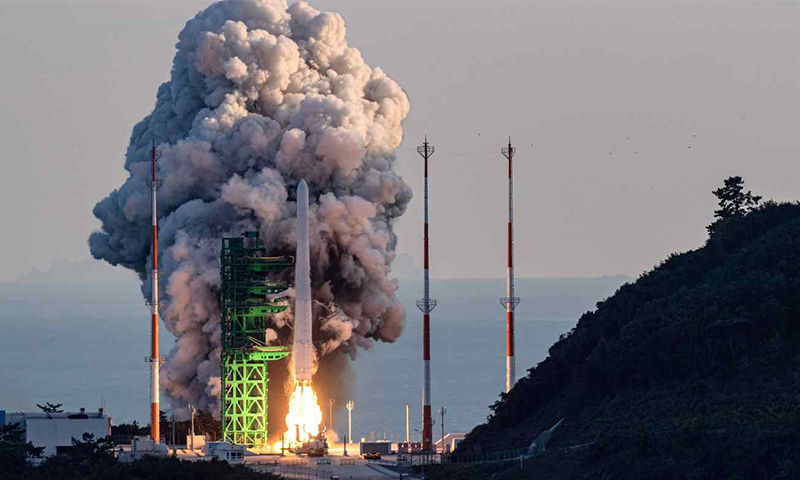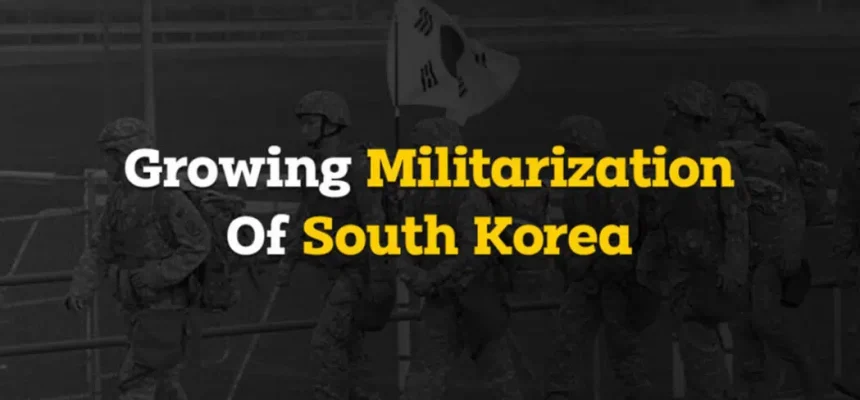South Korea is racing towards becoming a rising power in the region with its military and space programs in full swing, to create a strong deterrence against a belligerent North Korea.
South Korea successfully launched its homegrown rocket on 21st October, named Nuri. Although it failed to complete its mission, it still is a major step in South Korea’s militarization and space projects process. The incumbent President, Moon Jae-in commented that by 2030 South Korea will “achieve the dream of landing on the moon.”

Under Moon Jae-in’s government, South Korea has dramatically expanded its defense budget and it is likely to overtake Japan’s defense expenditures in a couple of years. The five-year defense budget is expected to take 266 billion USD of Seoul’s total expenditures.
The Korean Peninsula has been heating up over the years as a belligerent North Korea (DPRK) exerts its nuclear muscle, with South Korea (ROK) trying to keep up its defenses as it dilly-dallies between the United States (US) and China.
Last year in July, South Korean President Moon Jae In spoke of “missile sovereignty” and in 2021 the US agreed to abolish the limitations on the South Korean missile range. Signed in 1979, initially, ROK could only make missiles with a range of 180 kilometers (km). Over time due to the tensions in the region, these ranges were expanded to 300 km (2001-2012), then eventually to 800 km from 2012 onwards. From 2021 May onwards, ROK now has the green signal to attain Intercontinental Ballistic Missile Systems (ICBMs), and submarine-launched ballistic missiles (SLBMs). But why is Seoul actively pursuing a policy opposite of denuclearisation?

The push for South Korea’s militarisation
First and foremost, ROK has been under constant threat from the DPRK. Their relation encompasses more than just a security dimension, as the historical and cultural aspects play a deeper role in the progression or regression of their relations. On multiple occasions Kim Jon Un has labeled the US and ROK as the “bad guys” and spoilers of peace, and that its militarization is merely a strategy to defend itself from conflict.
Despite a crippling economy, the DPRK has been surprising the world with back-to-back missile tests over the years with the growing military and technological prowess. Its Hwasong missile line is perhaps the strongest in terms of the ICBMs and this year in October it fired the “most powerful weapon” through a submarine launch into ROK’s and Japan’s coast. The nuclear diplomacy status between the two was already sensitive but it was disrupted when South Korea and the United States continued their usual naval drills in August this year. The North reacted by canceling communication lines and a cloud of uncertainty has shaken the Korean Peninsula.
Constant halting and resuming of inter-Korean lines suggest unpredictability in the region. ROK has enjoyed considerable advantage under the US umbrella but there are stark differences in their approach towards North Korea even as allies. The US has a clear pressure policy for the DPRK and both countries have unmanageable stances on the prerequisites for further diplomatic engagements. The Biden administration has labeled its policy towards DPRK one that is “calibrated” and “practical approach with the goal of denuclearisation”. However, it has shown no sign of North Korea’s demands like sanction relief or other diplomatic risks.

America expects the ROK to follow through with its stream of policy but over the years the divergences in ROK-US policy have become evident. ROK still believes in the principle of the Sunshine policy of reunification with the North and wants to maintain its communication to ensure peace on the 38th parallel until then. Despite South Korean hopes for a diplomatic resolution with the North, it has felt the need to secure itself, possibly shrinking reliance on US support.
In “Seoul is not Kabul ”, Clint Work, a Stimson Centre fellow examined the impact of US pullout in Afghanistan on South Korean perceptions of US security. The two leaders have on different accounts shared their commitment to “a combined defense posture” under the U.S.-South Korea Mutual Defense Treaty and to the US. readiness to defend South Korea with its full range of capabilities. While the conditions are different from Kabul, the promise made is the same. Seoul wants to build its self-reliance against any threat for its survival, hence it seeks hard power to rebalance itself in the region. South Korea plans to utilize its space projects for enhanced reconnaissance satellites that can help it track North’s activities. South Korea is aiming to complete its “kill chain” defense and strike systems.

Apart from North Korea, China remains the ‘dragon’ in the room. The Indo-Pacific policy of the US demands that its allies take a firm stance against China. Countries like Japan are standing shoulder to shoulder with the US on DPRK and China issues. But South Korea has shown reluctance to offend China for several reasons. First, it has already witnessed firsthand China’s reaction to the US deployment of THAAD (Terminal High Altitude Area Defence) systems in South Korea. South Korea has economic relations with China, and the reality is China is a regional power that South Korea cannot compete against. Once US interests are fulfilled, South Korea will be left with an angry dragon, so its maintaining ‘strategic ambiguity in its foreign relations while also strengthening its capabilities to tackle unforeseen events. The incumbent ROK administration wants to secure Seoul from the security threats emanating from the US-China rivalry.

Furthermore, this will also give South Korea a chance to advance its domestic defense industry. The government has already issued for greater investments together with the private sector for military research and by 2026 it is expected to spend 7 trillion Korean won. The defense industry is more than willing to eventually export its cutting-edge technology to potential buyers- it is after all the most profitable business.
This shift from soft power to hard power comes as a result of the ROK pursuing its “wartime operational control from the US” according to an official source. Seoul now understands that its military strength will also provide it with an edge when negotiating with North Korea and other actors in Asia. However, as is the state of geopolitical affairs, the impact of South Korea’s militarization in Asia has already begun, with no signs of denuclearisation in the Peninsula.






